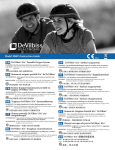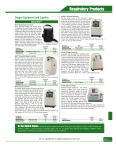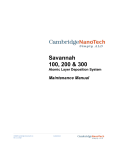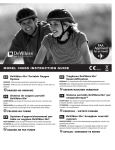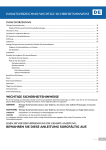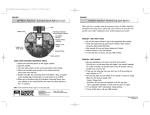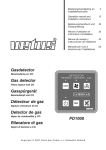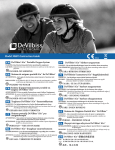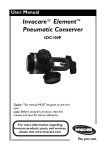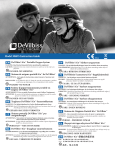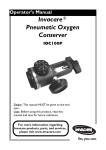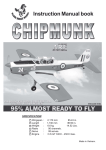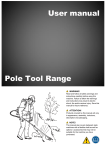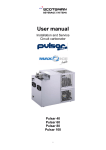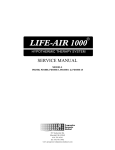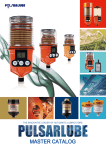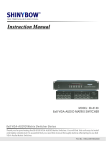Download LT-1859RevA PD1000 SM
Transcript
DeVilbiss PulseDose LT ® ® Compact Conserving Device Model PD1000 Service Manual ® C US LR 47089-112 Table of Contents 2 TABLE OF CONTENTS I. GENERAL INFORMATION ................................................................... 3 A. Initial Inspection......................................................................... 3 B. Maintaining the PD1000................................................................ 3 C. General Description ...................................................................... 3 II. THEORY OF OPERATION .................................................................... 3 III. INSTALLATION AND OPERATION ........................................................ 4 A. Installation ................................................................................. 4 B. Operation.................................................................................... 5 IV. MAINTENANCE PROCEDURES ............................................................. 5 A. Testing ....................................................................................... 5 B. Cleaning ..................................................................................... 5 V. TROUBLESHOOTING.......................................................................... 6 VI. SERVICE INSTRUCTIONS.................................................................... 7 A. Tank Seal Replacement.................................................................. 7 B. Battery Door/ Battery Removal ...................................................... 7 C. Cover Removal ............................................................................. 7 D. Cannula Removal.......................................................................... 7 E. Solenoid/Vacuum Switch Removal................................................... 7 VII. PARTS AND ILLUSTRATIONS .............................................................. 8 VIII. PNEUMATIC DIAGRAM ...................................................................... 9 IX. UNIT SPECIFICATIONS ...................................................................... 9 X. PARTS RETURN AND ORDERING POLICY.............................................. 10 XI. WARRANTY ..................................................................................... 11 LT-1859 I. General Information / II. Theor y of Operation 3 I. GENERAL INFORMATION A. INITIAL INSPECTION An initial inspection should be performed on the PD1000 as soon as possible after receipt. When removed from carton, an inspection should be made for any damage due to shipping. If shipping damage has occurred, call Sunrise Medical at 800-333-4000 (814-443-4881) for replacement instructions. B. MAINTAINING THE PD1000 The PD1000 should be periodically maintained according to the guidelines set forth in Section IV. Maintenance and testing should only be done by qualified service personnel. Failure to follow the procedures set forth in this manual may void the warranty. C. GENERAL DESCRIPTION The PD1000 PulseDose system delivers a pulse or “bolus” of oxygen at the leading edge of inspiration. This bolus is delivered at both the proper flow and volume so that it is delivered deep into the lungs where gas exchange takes place. The PD1000 PulseDose is rate responsive from 6 BPM to 40 BPM. The PD1000 is 4.75"L x 3.4"W x 2.8"H. It weighs 16.3 ounces with battery. II. THEORY OF OPERATION The PD1000 utilizes a vacuum switch to detect the negative pressure at the beginning of each inspiration (approximately .1 inches water column due to inhalation). That, in turn, drives the solenoid for a time interval that corresponds to the flow rate selected on the rotary selector. At higher flow rates, the valve is open longer resulting in increased pulse volumes. Atmospheric pressure compensation occurs automatically because the pressure side of the vacuum switch is open to atmosphere. All PD1000 units are set on 2 liters per minute continuous flow from the factory. Changing to a different continuous flow rate involves changing the cannula fitting as outlined in Section VI, D. The PD1000 delivers 16.5 cc O2 per setting number (i.e. setting 2 = 33cc O2). LT-1859 III. Installation and Operation 4 III. INSTALLATION AND OPERATION 1 Battery Door A. INSTALLATION The PD1000 utilizes a rotary selector that has three modes for use by the patient. Those modes are: OFF, “PulseDose”, and Continuous Flow. The PD1000 is battery operated and must be turned off by turning the Rotary Selector to the “OFF” position. The unit requires (2) “AA” batteries to operate in PulseDose mode (Figure 1). The battery does not become discharged as a result of not turning the Rotary Selector to the “OFF” position. Press latch to open door The PD1000 mounts on a standard CGA870 type post using guide pins and the knob (Figure 2). It can be used on C, D, E, ML-6, M4 and M-6 size tanks at pressures between 500-2250 PSIG. Also verify that the regulator seal (Part #9286-RD) is in place and in good condition (Section VI, A). Position the guide pins into the tank post holes, and tighten the knob until the PD1000 is securely in position and there are no seal leaks. 2 The tank valve can now be slowly opened. The rotary selector can be set to the prescribed flow rate. Verify that a pulse is being delivered at the leading edge of each inhalation. As the flow rate is increased, so is the duration of the pulse (Figure 3). To use the PD1000 in the “Continuous Flow” mode, turn the Rotary Selector to the “CF” position (Figure 4). See Note in the Important Parts section of the instruction guide A1000. The “CF” flow rate is set at 2 liters per minute. This flow rate can be changed by changing cannula fittings (Figure 5). See Service Instructions Section VI, D. 3 Rotary Selector 4 “CF” 5 Cannula Fitting LT-1859 III. Installation and Operation / IV. Maintenance Procedures 5 B. OPERATION 6 When using the PD1000 in the PulseDose mode, the patient must breathe through the nose only. A standard nasal cannula must be used. Do not use pediatric or low-flow cannula. The cannula is connected to the cannula fitting. The cannula tubing can be up to 35 feet in length, but a 10 foot maximum is recommended to lessen the chances of the oxygen cylinder tipping over while in use. Do not use on patients who can only mouth breathe. The PD1000 can only be used on patients capable of nose breathing and can not be used on mouth breathers. Battery Indicator Lights Remaining battery life can be observed as the Pulse Indicator Lights illuminate with each breath (Figure 6). 7 If the Green Pulse Indicator Light illuminates with each breath, the batteries have sufficient power (8 or more hours). If the Red Pulse Indicator Light illuminates with each breath, the batteries have between 4 – 8 hours of battery life remaining. If the Red Indicator Light illuminates continuously, the batteries must be changed. The unit can be used on the continuous flow “CF” setting if no batteries are immediately available. NOTE– Turn the Rotary Selector to the OFF setting prior to changing batteries. Contents Gauge NOTE– The oxygen cylinder will not last as long in continuous flow mode as it would in PulseDose mode. The contents gauge indicates the approximate amount of oxygen left in the tank. It reads 1/4, 1/2, 3/4, and full. It also has a red area to emphasize when the tank needs to be changed (Figure 7). The operating temperature range of the PD1000 is 41° - 104° F (5°- 40°). The humidity range is 0 – 95% R. H., non-condensing. The atmospheric pressure range is 500 to 1020 millibar. IV. MAINTENANCE PROCEDURES A. TESTING NOTE– These tests only need to be performed after a repair or if the unit is going out on a new patient. 1. Install known good batteries. 2. Connect the unit to a pressurized oxygen cylinder as described in Section III-A and connect a nasal cannula. 3. Open the tank valve and verify that the PD1000 contents gauge indicates that there is a full tank. 4. Verify that there are no leaks around the tank seal between the PD1000 and the oxygen tank. 5. Select any flow rate and simulate an inhalation through the nasal cannula while verifying that a “pulse” or bolus of oxygen is delivered with each simulated breath. 6. Position the Rotary Selector to the “CF” position and verify that the Continuous Flow Mode of operation is functioning. 7. Verify that the top and bottom covers are not cracked or broken. 8. Verify that the label can be read and is not damaged. 9. Turn the Rotary Selector to the “OFF” position, close the tank valve, and remove PD1000 from cylinder. B. CLEANING Clean the device periodically by wiping it with a dry, lint-free cloth. Do not clean the unit with a solvent based cleaning solution. LT-1859 V. Troubleshooting 6 8 V. TROUBLESHOOTING Please select from the types of problems listed below and follow the recommended action to logically troubleshoot and diagnose the problem. PROBLEM Type I– The unit does not deliver a pulse with each inhalation, and the unit is properly connected to a pressurized cylinder with the post valve open. LT-1859 ACTION 1. Verify that the batteries are good and of specified type. 2. If batteries are good, verify proper cannula connection and that patient is nose breathing. 3. If yes, remove top and bottom covers (Section VI, C). Use a digital volt meter and check the resistance across the Vacuum Switch (Figure 8) with Rotary Selector “OFF” when breath is simulated. 4. If the resistance doesn’t go to “0” when breath is simulated, change the vacuum switch. 5. If the resistance goes to “0” check the solenoid voltage (Figure 9) when breath is simulated and set to 6 LPM. 6. If no voltage is present, change the PC Board. 7. If voltage is present, change the solenoid. Type II– The regulator is leaking or the gauge is broken or not reading accurately. Refer to Section VI to remove the Regulator/Gauge Assembly and replace the gauge or regulator. Type III– The cannula fitting is broken. Refer to Section VI, D to change the cannula fitting. Type IV– There is leakage between the tank and the PD1000. Close the tank valve, loosen the knob and verify that the post, the PD1000 regulator yoke, and the tank surfaces are smooth and free of burrs. If they are smooth, replace the tank seal (#9286-RD). Refer to section VI, A. Type V– Broken or missing battery door. Replace battery door. (PD1000D-608) Type VI– Broken, damaged, or non-functioning rotary selector. Remove covers and replace rotary selector of PC Board. Refer to Section VI, C. Type VII– Unit won’t pulse. Remove covers (Section VI, C). Test vacuum switch, PC Board, and Solenoid (Section VI, E). 9 VI. Service Instructions 7 VI. SERVICE INSTRUCTIONS 10 11 A. TANK SEAL REPLACEMENT Start by closing the tank valve so that no pressure is supplied to the PD1000. Loosen the knob so that the guide pins slide out of the indexing holes in the tank post. Remove and replace the defective seal (Part # 9286-RD) (Figure 10). 1 2 4 3 B. BATTERY REMOVAL 5 NOTE– Turn the rotary selector to the “OFF” setting and wait approximately 15 seconds prior to changing batteries. 12 Open the battery door by pushing back on the latch and lifting (Figure 11). Remove batteries (“AA”) for replacement. Note the polarity when removing. The polarity is also indicated in the battery compartment. 13 13 7 8 10 11 C. COVER REMOVAL/REGULATOR GAUGE 12 Position the PD1000 face down so that the back cover is facing up. Remove the 5 cover screws (Figure 12) and remove the rear cover. Stand the unit on its side and (Figure 13) remove the circuit board/manifold assembly. Slide the front cover off the regulator. The Rotary Selector will also lift out when the front cover is removed (Figure 14). The regulator/gauge can then be removed by disconnecting from regulator hose. See VII - Inside Parts. 6 9 14 14 15 10 8 15 D. CANNULA FITTING REMOVAL/REPLACEMENT 9 NOTE– When removing or installing the cannula fitting, orient the manifold so the fitting faces down to prevent any debris from falling into the manifold which could obstruct the continuous flow orifice. 16 17 Use a 5/16” open end wrench and remove the cannula fitting by turning it counter-clockwise. Replace with a new cannula fitting and torque to 10 inch-lbs. 16 E. SOLENOID/VACUUM SWITCH TESTING AND REMOVAL Connect a piece of tubing to the cannula fitting so that a negative pressure can be created. Using a digital voltmeter, check the resistance across the vacuum switch as a negative pressure is created (Figure 8). If the resistance doesn’t go to “0” when a breath is drawn, replace the vacuum switch. If it goes to “0” but the solenoid doesn’t fire, check the solenoid voltage (3VDC). If there is no voltage, change the PC Board. If there is voltage, replace the solenoid (Figure 15). To replace the vacuum switch, pull it apart from the manifold/solenoid and the PC Board terminals (Figure 16). The vacuum switch can then be replaced by pushing the manifold, vacuum switch, and PC Board together. No tools are required. 11 10 12 1. 2. 3. 4. 5. 6. Post Guide Pins Regulator Seal Battery Door Battery Door Latch Cover Screws 7. Slot for Gauge 8. Cannula Fitting 9. Solenoid 10. Manifold 11. Vacuum Switch 12. PC Board 13. Front Cover 14. Knob Opening 15. Rotary Selector Knob 16. Solenoid Wires 17. Solenoid Terminals LT-1859 VII. Parts and Illustrations 8 VII. PARTS AND ILLUSTRATIONS 1 Part Part Number Qty 1. PC Board PD1000D-607 1 2 Solenoid/Manifold PD1000D-604 1 3. Vacuum Switch PD1000D-605 1 4. Regulator/Gauge PD1000D-606 1 5. Regulator Seal 9286-RD 1 2 3 4 5 6. Regulator Hose 1 6 Inside Parts Part Part Number Qty 1. Regulator Knob PD1000D-609 1 2. Cannula Fitting: Aluminum– 2 lpm Gold– 3 lpm Green– 4 lpm Blue– 5 lpm Red– 6 lpm PD1000D-612 PD1000D-613 PD1000D-614 PD1000D-615 PD1000D-616 1 3 2 4 7 Outside Parts LT-1859 6 5 1 3. Cover Screws 6x.25 PD1000D-611 3 4. Cover Screws 6x1 PD1000D-610 2 5. Battery Door PD1000D-608 1 6. Top/Bottom Cover PD1000D-601 1 7. Rotary Selector PD1000D-602 1 VIII. Pneumatic Diagram / IX. Unit Specifications 9 VIII. PNEUMATIC DIAGRAM IX. UNIT SPECIFICATIONS Weight.....................................................................................................14.7 ounces 16.3 ounces with battery Dimensions .............................4.75”Lx3.4”Wx2.8”H (12.06 cm L x 8.64cm W x 7.11 cm H) Power Supply ...........................................................(2) Standard “AA” alkaline or NiMH. Note– Batteries other than alkaline or NiMH are not recommended due to their limited capacities. Operating Temperature Range ................................................5º to 40º C (41º to 104ºF) Operating Pressure Range .........................500 to 2250 PSIG (34 to 155 Bar) tank pressure Operating Atmospheric Conditions....................................................500 to 1020 millibar Operating Humidity Range ...............................................0 to 95% R.H., non-condensing Storage and Transportation Temperature Range .......................20º to 60º C (-4º to 140º F) Storage and Transportation Humidity Range .....................Up to 95% R.H., Non-condensing Degree of Protection Against Ingress of Liquids.......................................................None Degree of Protection Against Electric Shock ......................................TYPE BF applied part Modes of Operation...........................................................................Continuous/Pulsed Approval Body And Safety Standards: ...................IEC 601-1;CAN/CSA-C22.2 No. 601.1-M90 and IEC 601-1-2 US Patents ..................................................................4,519,387; 5,755,224; 4,457,303 LT-1859 X. Parts Return and Ordering Policy 10 X. PARTS RETURN AND ORDERING POLICY ALL DEFECTIVE COMPONENTS THAT ARE STILL UNDER WARRANTY MUST BE RETURNED TO THE FACTORY IN SOMERSET, PA WITHIN 30 DAYS AFTER SHIPMENT OF THE NEW COMPONENTS. IF THE COMPONENTS ARE NOT RECEIVED WITHIN THIS PERIOD, AN INVOICE WILL BE ISSUED TO YOUR ACCOUNT. Before returning parts or units to the factory, call the Sunrise Medical Customer Service Department at 800-333-4000 or 814-443-4881 to obtain a return authorization number. Include in the package a note indicating the return authorization number along with your company name, address, phone number, and account number. The return authorization number should also be written on the outside of the package. To expedite your order for warranty or non-warranty parts, the following information should be given to the representative: • Catalog Number • Unit Serial Number • Account Number • Company name, address, and phone number ORDERING INFORMATION When ordering components, instruction guides, or service manuals the following must be provided: • • • • • Unit Catalog Number Unit Serial Number Part Number Quantity Required Orders may be placed by calling: Customer Service 800-333-4000 Canada 905-660-2459 International Department 814-443-4881 Technical Service 800-333-4000 LT-1859 XI. Warranty 11 XI. WARRANTY THREE-YEAR LIMITED WARRANTY DeVilbiss PulseDose LT Compact Conserving Device is warranted to be free from defective workmanship and material for a period of three years from date of purchase. Any defective part(s) will be repaired or replaced at Sunrise Medical’s option if the unit has not been tampered with or used improperly during that period. Make certain that any malfunction is not due to inadequate cleaning or failure to follow the instructions. If repair is necessary, contact your Sunrise Medical provider or Sunrise Medical Service Department for instructions: USA 800-333-4000 or 814-443-4881 Canada 905-660-2459 Europe 44-138-444-6688 NOTE– This warranty does not cover providing a loaner unit, compensating for costs incurred in rental while said unit is under repair, or costs for labor incurred in repairing or replacing defective part(s). THERE IS NO OTHER EXPRESS WARRANTY. IMPLIED WARRANTIES, INCLUDING THOSE OF MERCHANTABILITY AND FITNESS FOR A PARTICULAR PURPOSE, ARE LIMITED TO THE DURATION OF THE EXPRESS LIMITED WARRANTY AND TO THE EXTENT PERMITTED BY LAW ANY AND ALL IMPLIED WARRANTIES ARE EXCLUDED. THIS IS THE EXCLUSIVE REMEDY AND LIABILITY FOR CONSEQUENTIAL AND INCIDENTAL DAMAGES UNDER ANY AND ALL WARRANTIES ARE EXCLUDED TO THE EXTENT EXCLUSION IS PERMITTED BY LAW. SOME STATES DO NOT ALLOW LIMITATIONS ON HOW LONG AN IMPLIED WARRANTY LASTS, OR THE LIMITATION OR EXCLUSION OF CONSEQUENTIAL OR INCIDENTAL DAMAGES, SO THE ABOVE LIMITATION OR EXCLUSION MAY NOT APPLY TO YOU. This warranty gives you specific legal rights, and you may also have other rights which vary from state to state. LT-1859 Sunrise Medical Respiratory Products Division 100 DeVilbiss Drive Somerset, Pennsylvania 15501 (800) 333-4000 (800) 338-1988 (814) 443-4881 In Canada (800) 263-3390 © Sunrise Medical 03.03 LT-1859 Rev. A












